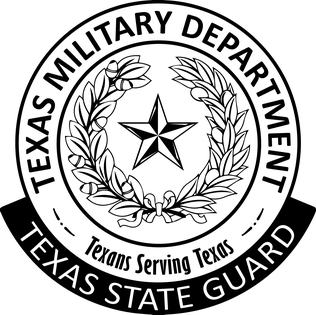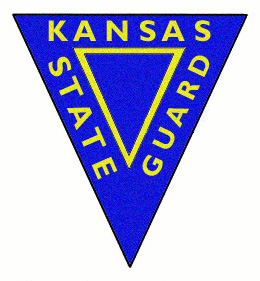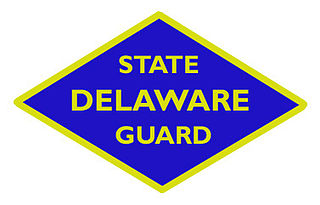Related Research Articles

In the United States, state defense forces are military units that operate under the sole authority of a state government. State defense forces are authorized by state and federal law and are under the command of the governor of each state.

A naval militia is a reserve military organization administered under the authority of a state government in the United States. It is often composed of reservists of the Navy Reserve, Marine Corps Reserve, and Coast Guard Reserve, retirees and volunteers. They are distinguishable from the U.S. Coast Guard Auxiliary which is a federally chartered civilian volunteer component of the U.S. Coast Guard and falls under the command of the Commandant of the Coast Guard through the Chief Director of the Auxiliary, and the United States Maritime Service and United States Merchant Marine, both of which are federal maritime services.

The New York Guard (NYG) is the state defense force of New York State, also called The New York State Military Reserve. Originally called the New York State Militia it can trace its lineage back to the American Revolution and the War of 1812.

The Virginia Defense Force (VDF) is the official state defense force of Virginia, one of the three components of Virginia's state military along with the Virginia National Guard which includes the Virginia Army National Guard, the Virginia Air National Guard, and the unorganized militia. As of 2019, the VDF has approximately 250 soldiers. The VDF is the descendant of the Virginia State Guard, the Virginia Regiment, and ultimately the Colonial Virginia militia of the Virginia Colony.

The Texas State Guard (TXSG) is part of the state military force of Texas, and one of three branches of the Texas Military Forces. Along with the other two branches, the TXSG falls under the command of the Governor of Texas and is administered by the Adjutant General of Texas, an appointee of the Governor. The other two branches of the Texas Military Forces are the Texas Army National Guard and the Texas Air National Guard.

The South Carolina State Guard (SCSG) is the designated state defense force for the state of South Carolina.

The Puerto Rico State Guard (PRSG) —Spanish: Guardia Estatal de Puerto Rico— is the state defense force of Puerto Rico that operates under the sole authority of the governor of Puerto Rico who, in turn, delegates such authority to the Puerto Rico Adjutant General. The Guard's secondary purpose is to assume the state mission of the Puerto Rico National Guard in the event that the National Guard is mobilized. The first incarnation of the PRSG was created in 1941 in response to World War II and it disbanded in 1946. The PRSG was revived in 1971 and has remained in continuous existence since then. The PRSG is one of the few state defense forces of the United States that has an air division.

The Washington State Guard is the state defense force of the U.S. state of Washington. It is an element of the state's military forces which also include the Washington Army National Guard and the Washington Air National Guard.
The reserve components of the United States Armed Forces are military organizations whose members generally perform a minimum of 39 days of military duty per year and who augment the active duty military when necessary. The reserve components are also referred to collectively as the National Guard and Reserve.

The Tennessee State Guard (TNSG) is the state defense force of the state of Tennessee. The TNSG is organized as an all-volunteer military reserve force whose members drill once per month unless called to active duty. The TNSG is a branch of the Tennessee Military Department, alongside the Tennessee Army National Guard, the Tennessee Air National Guard, and the Tennessee Emergency Management Agency. The State Guard acts as a force multiplier for the state's National Guard. As a state defense force, the Tennessee State Guard cannot be federalized, and is not deployed outside the borders of Tennessee, as it is a purely state-level unit. It answers solely to the Governor of Tennessee, unlike the dual federal and state controlled National Guard. The creation of a state military force is recognized under Tennessee Code Annotated 58-1-401.

The Kansas State Guard was the official state defense force of the state of Kansas during each of the world wars. The unit was first created during World War I, and was later reactivated during World War II. When the Kansas National Guard was federalized and deployed during each of the world wars, the state of Kansas was forced to raise and maintain its own military force in order to protect against saboteurs, quell riots, and perform other duties which would normally fall to the National Guard. Unlike the National Guard, which could be federalized and deployed abroad, the State Guard was funded and equipped solely by the state and as such was immune to deployment. The Kansas State Guard is authorized under Kansas law. In 2007, the Kansas Legislature considered a bill which would create a modern Kansas State Defense Force. The bill did not pass.

The Florida State Guard (FSG) is the state defense force of the U.S. state of Florida. The FSG was created in 1941 to serve as a stateside replacement for the Florida National Guard while the National Guard was deployed abroad during World War II. The FSG is available to the governor of Florida whenever needed, but unlike the National Guard, the FSG is trained and funded by the state and therefore can not be federalized. The FSG was reactivated in 2022 after the Florida legislature appropriated US$10 million in funding.

The Delaware State Guard is the currently inactive state defense force of the state of Delaware, which was active during both World War I and World War II. As the official militia of the state, the Delaware State Guard was created with the intent of acting as a stateside replacement for the Delaware National Guard while the National Guard units were deployed abroad.

The Pennsylvania State Guard is the currently inactive official state defense force of the state of Pennsylvania, which was active during World War II and the Korean War. The unit was organized as a home guard composed of volunteers who were trained and organized as parallel to the state’s National Guard. As a part of Pennsylvania's official militia, the Pennsylvania State Guard was trained, organized, and funded by the state of Pennsylvania, answered to the governor, and could not be federalized or deployed abroad.
The Hawaii Territorial Guard was the state defense force of Hawaii during World War II. As a result of the National Guard of Hawaii being federalized for the duration of the war, the Hawaii Territorial Guard was created to serve as the stateside replacement for the National Guard. During the war, it was the sole military force available to the Governor of Hawaii as its captain general to use in defense of the state. Unlike the National Guard, as a state defense force, the Hawaii Territorial Guard was not subject to federalization or deployment outside of the borders of Hawaii, but rather answered only to the governor.
The Nebraska State Guard (NSG) is the currently inactive state defense force of the state of Nebraska, which was activated during both World War II and the Vietnam War. As a state defense force, the NSG served on as a component of the organized militia of Nebraska, serving as reservists who trained periodically but could be called up during an emergency; however, unlike the Nebraska National Guard, the Nebraska State Guard could not be federalized or deployed outside the state. Rather, when the National Guard was deployed, the purpose of the State Guard was to assume the stateside duties of the National Guard.

The Louisiana State Guard (LSG) is the official state defense force of the state of Louisiana. The LSG was first created during World War II. As a state defense force, the LSG is a part of the state militia of Louisiana, and can serve as a stateside replacement of the Louisiana National Guard while the National Guard is deployed. Unlike the Louisiana National Guard, the Louisiana State Guard is solely under state control, and cannot be federalized or deployed outside of Louisiana, guaranteeing additional soldiers will always be available to the governor to deploy in response to crises.

The New Hampshire State Guard (NHSG) is the currently unorganized state defense force of New Hampshire. The purpose of the State Guard is to augment or replace the New Hampshire National Guard by assuming the National Guard’s stateside duties when any part of the National Guard is federalized. However, unlike the National Guard, the State Guard is a purely state-level military force which cannot be federalized or deployed outside the state of New Hampshire. The NHSG is a component of the organized militia of New Hampshire.
The Illinois Reserve Militia was the state defense force of Illinois during World War I and World War II. After the Illinois National Guard was federalized, the Illinois Reserve Militia was organized to assume the stateside duties of the National Guard.
The New Jersey State Guard, previously known as the New Jersey State Militia, is the inactive state defense force of New Jersey, and is one of New Jersey's authorized military forces. The State Guard served as the stateside replacement for the New Jersey National Guard during World War I and World War II when the National Guard was deployed abroad.
References
- 1 2 "Military Code §29A.65" (PDF). Iowa Legislature Official Website. Retrieved 17 March 2015.
- 1 2 3 4 Snook, David L. "The Iowa State Guard (1942-1947)". Iowa National Guard Official Website. Archived from the original on May 6, 2006. Retrieved 26 March 2015.
- ↑ Stentiford, Barry M. (2002). The American Home Guard: The State Militia in the Twentieth Century. Texas A&M University Press. p. 188. ISBN 1585441813 . Retrieved 26 March 2015.
- ↑ Tucker, Phillip Thomas (1 February 2012). Father of the Tuskegee Airmen, John C. Robinson. Potomac Books, Inc. p. 61. ISBN 978-1597974875 . Retrieved 26 March 2015.
- ↑ "Women Form Military Order of the Guard". The University of Iowa Digital Library. 15 March 1943. Retrieved 26 March 2015.
- ↑ "32 U.S. Code § 109 Maintenance of other troops". Legal Information Institute. Cornell University Law School. Retrieved 26 March 2015.